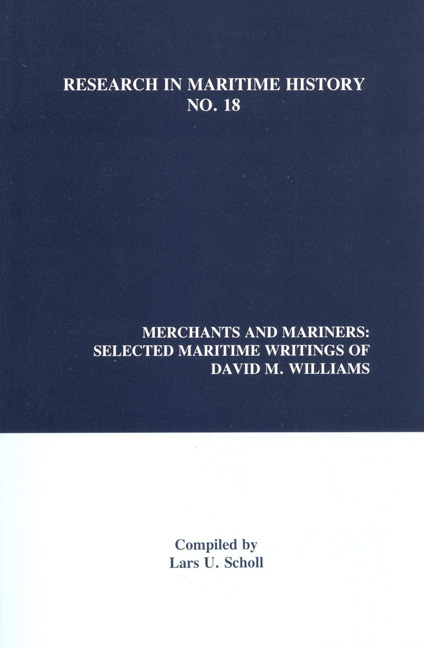Book contents
- Frontmatter
- Contents
- “Introduction”
- “David Malcolm Williams: A Tribute from an Old Friend”
- “David M. Williams and the Writing of Modern Maritime History”
- Writings
- “Abolition and the Re-Deployment of the Slave Fleet, 1807-1811”
- “Liverpool Merchants and the Cotton Trade 1820-1850”
- “The Shipping of the North Atlantic Cotton Trade in the Mid- Nineteenth Century”
- “Merchanting in the First Half of the Nineteenth Century: The Liverpool Timber Trade”
- “James Silk Buckingham: Sailor, Explorer and Maritime Reformer”
- “State Regulation of Merchant Shipping 1839-1914: The Bulk Carrying Trades”
- “Customs Evasion, Colonial Preference and the British Tariff, 1829- 1842”
- “Bulk Passenger Freight Trades, 1750-1870”
- “Henry Mayhew and the British Seaman”
- “Mid-Victorian Attitudes to Seamen and Maritime Reform: The Society for Improving the Condition of Merchant Seamen, 1867”
- '“Advance Notes' and the Recruitment of Maritime Labour in Britain in the Nineteenth Century”
- “The Quality, Skill and Supply of Maritime Labour: Causes of Concern in Britain, 1850-1914”
- “David M. Williams: A Bibliography”
“Abolition and the Re-Deployment of the Slave Fleet, 1807-1811”
from Writings
- Frontmatter
- Contents
- “Introduction”
- “David Malcolm Williams: A Tribute from an Old Friend”
- “David M. Williams and the Writing of Modern Maritime History”
- Writings
- “Abolition and the Re-Deployment of the Slave Fleet, 1807-1811”
- “Liverpool Merchants and the Cotton Trade 1820-1850”
- “The Shipping of the North Atlantic Cotton Trade in the Mid- Nineteenth Century”
- “Merchanting in the First Half of the Nineteenth Century: The Liverpool Timber Trade”
- “James Silk Buckingham: Sailor, Explorer and Maritime Reformer”
- “State Regulation of Merchant Shipping 1839-1914: The Bulk Carrying Trades”
- “Customs Evasion, Colonial Preference and the British Tariff, 1829- 1842”
- “Bulk Passenger Freight Trades, 1750-1870”
- “Henry Mayhew and the British Seaman”
- “Mid-Victorian Attitudes to Seamen and Maritime Reform: The Society for Improving the Condition of Merchant Seamen, 1867”
- '“Advance Notes' and the Recruitment of Maritime Labour in Britain in the Nineteenth Century”
- “The Quality, Skill and Supply of Maritime Labour: Causes of Concern in Britain, 1850-1914”
- “David M. Williams: A Bibliography”
Summary
The slave trade was a major branch of British overseas trade in the late eighteenth century. It employed upwards of 30,000 tons of shipping and in the decade after 1796, when the trade reached a peak of activity, over a hundred vessels a year left British ports for Africa on the first leg of the triangular voyage. By this date the British slave trade was dominated by Liverpool to such an extent that Liverpool sailings accounted for 1099 slave voyages out of a total of 1283 such voyages undertaken from British ports in the ten years from 1795 to 1804. However, while the trade enjoyed a boom period, the forces of abolition were steadily increasing in strength and influence and humanitarian interests gained their victory in May 1807 when the slave trade was abolished by Parliament. The coming of abolition, though anticipated, was a severe blow to all those with commercial interests in the slave trade. Merchants and shipowners in Liverpool looked on abolition with both alarm and despondency. Many forecast the ruination of the port and a contemporary observer prophesied the demise of its shipping, declaring that “Liverpool's glorious merchant navy, whose keels penetrated into every land, and whose white sails wooed the breeze on every ocean, was to dwindle into a fishing vessel or two.” Such dismal predictions were soon proved false, for Liverpool's commerce increased rapidly in the first half of the nineteenth century and the cotton trade assumed an importance far in excess of that ever held by the slave trade. Nevertheless the fact remains that, in the short run, abolition checked growth and caused major problems for operators previously engaged in the Africa trade, merchants had to seek new markets and outlets for capital, shipowners had to consider the redeployment of their vessels, and where, as was frequently the case in the slave trade, the function of merchant and shipowner was performed by the same individual, nothing short of a total redirection of resources was required. This paper seeks to examine one feature of this process of readjustment which was forced by the ending of the slave trade, namely, what became of the slave fleet after abolition, and in particular what trades ex-slave vessels were put into in the years immediately after 1807.
- Type
- Chapter
- Information
- Merchants and MarinersSelected Maritime Writings Of David M. Williams, pp. 1 - 18Publisher: Liverpool University PressPrint publication year: 2000



